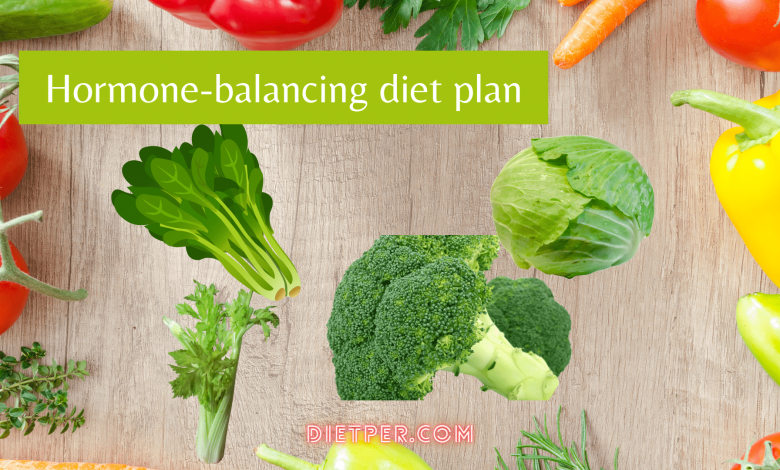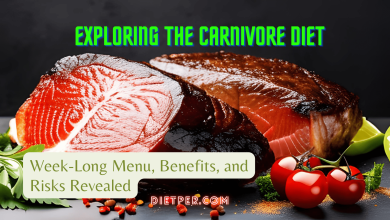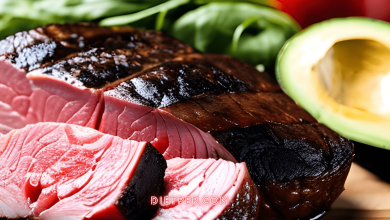Unlocking Vitality: Transform Your Health with a Hormone Balancing Diet Plan
Hormone Balancing Diet: A Simple and Effective Way to Improve Your Health and Mood

What is the Hormone Balancing Diet Plan?
A hormone balancing diet plan is a dietary approach that aims to promote the healthy production and activity of our hormones, which control many health functions, such as energy, emotions, stress and reproduction. When our hormones are imbalanced, we can suffer from problems like weight gain, mood swings, acne, fatigue and insomnia. A hormone-balancing diet plan can help prevent or alleviate these issues.
General Guidelines for a Hormone Balancing Diet Plan
A hormone balancing diet plan should follow these general guidelines:
- Increase protein intake: Protein is vital for building muscle and bone mass. It also supports maintaining your blood sugar levels and satisfies you for longer. Get 20 grams of protein each meal from eggs, fish, poultry, beans, nuts and seeds.
- Avoid sugar and refined carbs: These can increase insulin resistance, leading to diabetes and hormone imbalances. Avoid added sugars, white bread, pasta, rice, pastries and other processed foods. Opt for complicated carbs like whole grains, fruits as well as vegetables instead.
- Include healthy fats: Fats are not all bad for you. Some fats, such as omega-3 fatty acids, monounsaturated fats and medium-chain triglycerides (MCTs), can help lower inflammation, enhance brain function and support hormone production. Add chia seeds, flax seeds, avocados, olive oil, coconut oil and fatty fish to your diet.
- Eat the right amount of calories: Eating too much or too little can affect your hormone balance. Overeating can cause excess insulin and cortisol production, leading to weight gain and stress. Eating too little can cause low thyroid function, slowing your metabolism and affecting your mood. Eat a moderate amount of calories that match your activity level and goals.
- Include fatty fish: Fatty fish like salmon, tuna, mackerel, as well as sardines, are high in omega-3 fatty acids, which are vital for hormone health. Omega-3s can help reduce inflammation, enhance insulin sensitivity and regulate estrogen levels. Eat at least two portions of fatty fish per-week, or take a fish oil supplement if you don’t eat fish.
Sample 7-Day Hormone Balancing Diet Plan
Here is a sample 7-day hormone balancing diet plan
Day 1: Monday
- Breakfast: Greek yoghurt with berries and granola.
- Lunch: Chicken salad with lettuce, tomatoes, cucumbers, olives and feta cheese.
- Dinner: Roasted salmon with broccoli and brown rice.
Day 2: Tuesday
- Breakfast: Scrambled eggs with spinach and cheese.
- Lunch: Lentil soup with whole wheat bread.
- Dinner: Beef stir-fry with carrots, peppers, onions and quinoa.
Day 3: Wednesday
- Breakfast: Oatmeal with almond milk, banana and walnuts.
- Lunch: Turkey sandwich with whole wheat bread, lettuce, tomato as well as avocado.
- Dinner: Spaghetti squash with turkey meatballs as well as marinara sauce.
Day 4: Thursday
- Breakfast: Smoothie with spinach, blueberries, almond butter and protein powder.
- Lunch: Vegetable curry with chickpeas and cauliflower rice.
- Dinner: Roasted chicken with roasted potatoes and green beans.
Day 5: Friday
- Breakfast: Tomato and watermelon salad.
- Lunch: Panzanella salad with tomatoes, garlic, capers, avocado and bread cubes.
- Dinner: Salmon and chickpea salad with grilled peppers.
Day 6: Saturday
- Breakfast: French toast with strawberries and maple syrup.
- Lunch: Hummus wrap with whole wheat tortilla, hummus, lettuce, tomato and cucumber.
- Dinner: Vegetable lasagna with zucchini noodles, ricotta cheese and mozzarella cheese.
Day 7: Sunday
- Breakfast: Pancakes with blueberries and honey.
- Lunch: Chicken noodle soup with whole wheat noodles.
- Dinner: Roasted pork loin with roasted carrots and parsnips.
Hormone Balancing Diet Plan: What Foods to Eat and Avoid
Hormones are chemical messengers that regulate many aspects of our health, such as metabolism, mood, reproduction and stress. When our hormones are out of balance, we may experience weight gain, fatigue, mood swings, acne, insomnia and more. A hormone-balancing diet plan is a way of eating that supports the optimal functioning of our hormones and helps prevent or reduce these symptoms.
There is no one-size-fits-all diet plan for hormone balance, as different hormones may require different dietary approaches. However, some general principles apply to most hormone-related conditions. Here are some foods to eat and avoid on a hormone-balancing diet plan:
Foods to Eat
- Protein: Protein helps build muscle and bone mass. It also supports balance blood sugar groups and keeps you feeling full longer. The desire for 20 grams of protein per meal from sources such as eggs, fish, poultry, beans, nuts and seeds.
- Healthy fats: Fats have a terrible standing because people think they will gain weight. However, not all fats are created equal. Healthy omega-3 fatty acids, monounsaturated fats and medium-chain triglycerides (MCTs) can help reduce inflammation, improve brain function and support hormone production. Include chia seeds, flax seeds, avocados, olive oil, coconut oil and fatty fish in your diet.
- Fibre: Fibre is a type of carbohydrate that is not digested by the body. It helps lower cholesterol levels, balance blood sugar levels and promote bowel movements. Fibre also binds to excess estrogen and helps eliminate it from the body. Eat more fibre-rich foods like fruits, vegetables, beans, lentils, oats and quinoa.
- Cruciferous vegetables: Cruciferous vegetables like broccoli, cauliflower, cabbage, and kale help metabolize estrogen and prevent estrogen dominance. They also contain sulforaphane, a compound that has anti-cancer and anti-inflammatory properties. Eat the shortest one serving of cruciferous vegetables per day.
- Herbs and spices: Turmeric, ginger, cinnamon, garlic, rosemary and basil can help modulate hormone levels and enhance the flavour of your meals. They also have antioxidant and anti-inflammatory effects that can benefit your overall health.
Foods to Avoid
- Sugar and refined carbs: Sugar and cultured carbs like white bread, pasta, rice, pastries and other processed foods can increase insulin resistance, leading to diabetes and hormone imbalances. They also spike your blood sugar levels and cause cravings and mood swings. Avoid added sugars and choose complex carbs such as whole grains, fruits, and vegetables.
- Soy: Soy is a contentious food when it comes to hormone health. Soy contains phytoestrogens, plant compounds that mimic estrogen in the body. Some studies indicate that soy can help lower the risk of breast cancer and menopausal symptoms by modulating estrogen levels. However, other studies suggest soy can interfere with thyroid function and cause hormonal disruptions. The effects of soy may depend on the individual’s genetic makeup, health status and intake level. Select organic and fermented soy products such as tempeh, miso and natto if you eat soy.
- Dairy: Dairy products like milk, cheese and yoghurt can cause hormonal issues for some people. Dairy contains hormones such as estrogen and progesterone that can affect your hormone levels. Dairy can also trigger inflammation, acne and digestive problems for some people who are sensitive or intolerant to lactose or casein. If you eat dairy, opt for organic and grass-fed dairy products or dairy from sheep or goats.
- Gluten: Gluten is a protein located in wheat, barley and rye. Gluten can cause inflammation, leaky gut syndrome and autoimmune diseases for some people who are sensitive or allergic to it. Gluten can also affect your thyroid function and hormone balance by interfering with the absorption of nutrients and increasing your cortisol levels. Choose organic and whole-grain gluten products or gluten-free alternatives such as buckwheat if you eat gluten.
How can you follow the hormone-balancing diet plan healthily?
- Eat Whole, Nutrient-Dense Foods: Base your diet on whole, unprocessed foods that are rich in nutrients. Include a variety of fruits, vegetables, whole grains, lean proteins, and healthy fats. These foods provide essential vitamins, minerals, and antioxidants that support hormone production and balance.
- Include Healthy Fats: Healthy fats are essential for hormone production and overall health. Incorporate sources of omega-3 fatty acids (found in fatty fish, flaxseeds, chia seeds) and monounsaturated fats (found in olive oil, avocados, nuts) into your diet.
- Prioritize Protein: Include lean sources of protein such as poultry, fish, beans, lentils, quinoa, and tofu. Protein supports muscle development, helps stabilize blood sugar levels, and contributes to hormone balance.
- Control Carbohydrates: Choose complex carbohydrates like whole grains (brown rice, quinoa, whole wheat), legumes, and vegetables. These carbs have a lower glycemic index, helping to regulate blood sugar and insulin levels, which can impact hormone balance.
- Fiber-Rich Foods: High-fiber foods like vegetables, fruits, whole grains, and legumes aid digestion, help regulate blood sugar levels, and support gut health, which is connected to hormone balance.
- Moderate Sugar Intake: Excessive sugar consumption can lead to insulin resistance and hormone imbalances. Limit your intake of sugary foods and beverages, and opt for natural sweeteners in moderation.
- Stay Hydrated: Proper hydration is essential for hormone balance. Drink plenty of water throughout the day to support all bodily functions, including hormone regulation.
Hormone-Balancing Diet Plan: Potential Risks and Drawbacks
A hormone balancing diet plan is a way of eating that aims to support your hormone function and prevent or reduce hormonal symptoms such as weight gain, fatigue, mood swings, acne and insomnia. A hormone-balancing diet plan typically involves eating more protein, healthy fats, fibre, cruciferous vegetables, herbs and spices, avoiding sugar, refined carbs, soy, dairy, gluten and alcohol.
The potential disadvantages of following a hormone-balancing diet plan:
It may be difficult to follow
A hormone-balancing diet plan can be pretty restrictive and eliminate many foods that you may enjoy or rely on for convenience. For example, you may have to avoid meat, alcohol, sugar, dairy and gluten for specific periods. You may also have to avoid toxins such as BPA and certain food additives in many packaged and processed foods. These additional restrictions may make the diet too challenging or impractical for some people.
It may not suit your individual needs
A hormone-balancing diet plan is based on general principles that apply to most hormone-related conditions. However, different hormones may require different dietary approaches depending on your situation. For example, some people may benefit from soy products, while others may not. Some people may need more or less carbs, fats or protein than others. Some people may have allergies or intolerances to certain foods allowed on the diet. Therefore, a hormone-balancing diet plan may not suit your needs or preferences.
It may not have much effect on your hormones
A hormone-balancing diet plan claims to help balance your hormones and improve your health by changing what you eat. However, there is not much scientific evidence to support this claim. Hormones are influenced by many factors besides diet, such as genetics, age, stress, sleep, exercise and environmental exposures. Diet alone may not significantly impact your hormone levels or function. Moreover, there is no clear definition of a balanced or optimal hormone state for each person.
It may have some side effects
A hormone-balancing diet plan may cause some side effects or adverse reactions for some people. For example, eliminating certain foods such as gluten or dairy may cause withdrawal symptoms such as headaches, cravings or digestive issues. Increasing your intake of fibre or cruciferous vegetables may cause bloating, gas or constipation. Changing your macronutrient ratios may affect your energy levels, appetite or mood. Depending on your response, these side effects may be temporary or persistent.
Final Words





